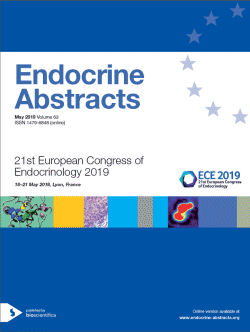
21st European Congress of Endocrinology
Lyon,
France
18 May 2019 - 21 May 2019
Guided Posters
Acromegaly and GH
ea0063gp48 | Acromegaly and GH | ECE2019
Prolonged diagnostic delay in acromegaly is associated with long-term morbidity and excess mortality: data from a nationwide study
Esposito Daniela , Ragnarsson Oskar , Johannsson Gudmundur , Olsson Daniel S
ea0063gp49 | Acromegaly and GH | ECE2019
Pharmacokinetics of somapacitan in individuals with renal impairment: an open-label, parallel group, phase 1 study
Bentz Damholt Birgitte , Bisgaard Charlotte , Louise Dombernowsky Sarah , Hojby Rasmussen Michael
ea0063gp50 | Acromegaly and GH | ECE2019
Sleep disorders and cognitive dysfunction in acromegaly
Dassie Francesca , Wennberg Alexandra , Lorusso Riccardina , Parolin Matteo , Russo Lucia , Mazzocut Sara , Benavides-Varela Silvia , De Carlo Eugenio , Martini Chiara , Vettor Roberto , Semenza Carlo , Maffei Pietro
ea0063gp51 | Acromegaly and GH | ECE2019
Prognostic value of short-acting pasireotide test for response prediction to pasireotide LAR in patients with acromegaly resistant to first-generation analogs. Can a short-acting pasireotide test predict the response of long-acting pasireotide treatment in patients with acromegaly resistant to first generation somatostatin analogs?
Majos Agnieszka , Stelmachowska-Banaś Maria , Czajka-Oraniec Izabella , Gęsior Jakub , Zgliczyński Wojciech
ea0063gp52 | Acromegaly and GH | ECE2019
Final height in childhood onset hypopituitarism
Esposito Andrea , Improda Nicola , Moracas Cristina , Barbieri Flavia , Alfano Sara , Capalbo Donatella , Salerno Mariacarolina
ea0063gp53 | Acromegaly and GH | ECE2019
Efficacy and safety of once-weekly somapacitan in adult growth hormone deficiency (AGHD) confirmed in a 53-week REAL-1 trial extension
Johannsson Gudmundur , Gordon Murray , Rasmussen Michael Hojby , Hakonsson Ida Holme , Svaerke Claus , Tahara Shigeyuki , Takano Koji , Biller Beverly MK
ea0063gp54 | Acromegaly and GH | ECE2019
Pharmacokinetics in patients with prolactinomas
Fedorova Natalia , Dzeranova Larisa , Pigarova Ekaterina , Vorotnikova Svetlana
ea0063gp55 | Acromegaly and GH | ECE2019
Acromegaly do not increase the risk of vertebral fractures: a retrospective and prospective study on 50 patients
Hochman Clarisse , Plard Charlotte , Le Bras Maelle , Le Goff Benoit , Maugars Yves , Guillot Pascale , Cariou Bertrand , Drui Delphine
ea0063gp56 | Acromegaly and GH | ECE2019
Sclerostin and fracture risk assessment in acromegaly
Halupczok-Żyła Jowita , Jawiarczyk-Przybyłowska Aleksandra , Zembska Agnieszka , Bolanowski Marek
ea0063gp57 | Acromegaly and GH | ECE2019
Biochemical control was sustained with long-acting pasireotide in patients with uncontrolled acromegaly over continued treatment with first-generation somatostatin analogues (SSAs): Results from the extension of phase 3b, open-label study
Gadelha Monica , Colao Annamaria , Bex Marie , Mukherjee Rishav , Bourad Catherine , Maamari Ricardo , Raverot Gerald
ea0063gp58 | Acromegaly and GH | ECE2019
ACROSTUDY – safety and efficacy in a cohort of 110 Naïve patients with acromegaly treated with pegvisomant
Wajnrajch Michael , Gomez Roy , Hey-Hadavi Judith , Kelepouris Nikoletta , van der Lans Joli , Loftus Jane , Camacho-Hubner Cecilia , Fleseriu Maria , Salvatori Roberto , Cara Jose , Palladino Andrew
ea0063gp59 | Acromegaly and GH | ECE2019
Effects of pegvisomant and pasireotide LAR on incidence of vertebral fractures in patients with acromegaly resistant to treatment with first-line somatostatin analogs
Chiloiro Sabrina , Giampietro Antonella , Bianchi Antonio , Bima Chiara , Frara Stefano , Mirra Federica , Donfrancesco Federico , Fleseriu Cara Maria , Fleseriu Maria , Giustina Andrea , Laura De Marinis , Pontecorvi Alfredo
ea0063gp60 | Acromegaly and GH | ECE2019
Metabolic outcome in adolescents with growth hormone deficiency during transition phase
Improda Nicola , Anselmi Federica , Alfano Sara , D'Acunzo Ida , Bufalo Lorenzo , Capalbo Donatella , Salerno Mariacarolina



